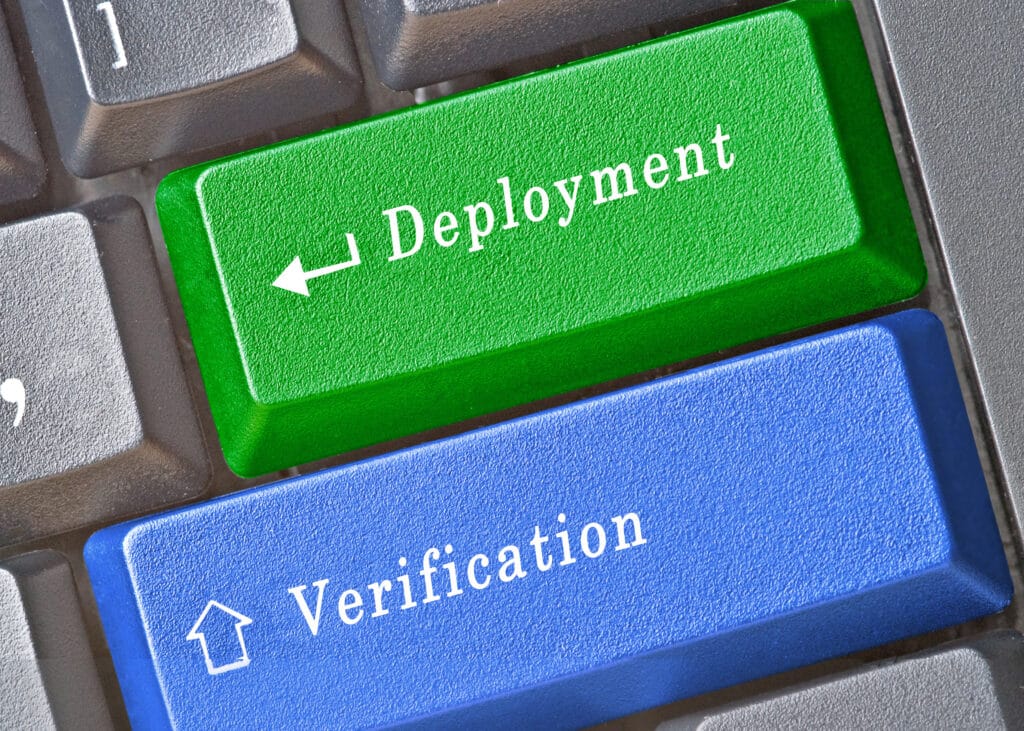

In today’s fast-paced, digital age, time to market is key to enabling sophisticated, cross-business operations, delivering a differentiated customer experience and supporting increased regulatory oversight.
Yet, many financial services firms find this impossible to achieve, as they are bottlenecked by inefficient and siloed processes for software and technology testing.
From having to test an entire system if a bug is found in one small section, to struggling to build in new products into tech platforms that were created decades ago, there are a wide variety of frustrating issues with how testing is currently done in the industry today.
To innovate and keep up with today’s market, testing needs to change. But how?
Enter blue-green deployment.
Blue-green deployment in cloud native infrastructure offers new opportunities to optimize software deliveries and updates for SaaS users without months of testing and resource draining. But what is blue-green deployment? How does it work and how is it going to change the way organizations test and release new features and capabilities?
What is Blue-Green Deployment?
Blue-green deployment is a software deployment strategy in which developers create two completely separate application instances — the blue environment and the green environment.
The blue environment is the existing application currently in production.. This is the version of the application that users actively access while the new version is tested.
Meanwhile, the green environment is this new version of the application. All inputs to the blue are also applied to the green. Thanks to the blue environment running simultaneously, developers can continue tweaking and testing the green environment without disrupting the user experience in the original application.
Once the green environment is complete and validated, traffic from the blue environment is redirected to the green one, and the blue environment is retired. The green environment becomes the blue one, and a new green one is created to develop and test new features and fixes.
At any given time, only one of these environments is made available to end-users.
Blue-green deployment is not a new concept, but it is a massively under-utilized strategy in the financial services industry due to the costs, resources, and the development effort needed to perform this type of deployment when working with legacy systems. Despite this, other industries are successfully leveraging and enjoying the benefits of blue-green deployments.
For asset servicers, asset managers and asset owners in traditional on-premises deployments that rely on legacy technology, upgrading or updating an application is a painful, tiring, trying, laborious process. This is due in large part to the fact that traditional legacy systems are more difficult to test. They rely on relational databases (SQL), rigid architecture, and dated methodologies. It usually means the entirety of the application code must be copied to a new server for each release, regardless of where the code changes occurred or how limited the changes were.
Another challenge for older software and databases that can prevent blue green deployment methods is when SQL databases are used and there are changes to the database from one version to the next. SQL databases have a rigid fixed schema design and structure that make blue green dual processing more difficult. NoSQL big-data cloud databases are easily scalable, flexible and relatively simple to use due to their flexible schema
As a result, testing is a key challenge associated with traditional deployments. Software testing has long been an inhibitor to deployment efficiency, and this results in many companies choosing to only update their software or deploy new releases once a year, sometimes once every few years. This even results in some teams foregoing their software and creating quick workarounds in the form of disjointed, manual spreadsheets, creating inefficient internal processes and a whole new layer of challenges that further slow the next release.
Blue-green deployments, a methodology FundGuard is using and championing, can help solve this issue, enabling testing in one environment on behalf of the client while maintaining the existing application in the other environment.
When cloud native computing is added to the equation, the potential advantages of this approach are magnified.
Some of the key advantages of cloud-based blue-green deployment include:
● Reduced Testing Hassle: Testing is time-consuming when using traditional systems, as applications must be updated and tested as a whole rather than in individual parts. Blue-green deployment based in the cloud offers key capabilities that enable more service-specific and efficient testing. New features and upgrades to software can be deployed without the fear of getting stuck in a testing bottleneck, while testing responsibilities can be offloaded onto the SaaS providers.
● Boosted Rollback Efficiency: Speaking of efficiency, blue-green deployments allow more efficient rollbacks in the event of a deployment going wrong. According to an AWS whitepaper, blue-green deployment “— reduces deployment risk by simplifying the rollback process if a deployment fails.” Moreover, a blue-green deployment enables a CI/CD system, as this type of deployment makes it easier to put changes to software into production quickly.
● Minimized Downtime: Blue-green deployments that are born in the cloud can cut back on the time and expenses of hosting multiple instances while also ensuring minimal downtime. Unlike traditional systems that use monolithic compiled applications, blue-green deployments with cloud native applications can utilize microservices to make small changes to individual sections without putting the application as a whole at risk of downtime or development error.
Microservices are an architectural approach to creating applications in the cloud. Traditional systems use a monolithic architecture that treats all processes in an application as a single service. Comparatively, microservices enable applications to be built using independent components that run as separate services.
Having the ability to make adjustments to individual components of an application rather than changing the application as a whole is a game-changer for testing and releases.
This makes microservice a core enabler of cloud-based blue-green deployment, as it helps segment the testing process, ensuring asset managers and their service providers don’t have to test the entire system every time, instead, they can test a single, independent, segmented section, when required.
For asset managers and asset servicers who need to compete in today’s market, having the ability to deploy new application features without affecting the end-user experience is paramount.
Like all things, blue-green deployment has its ideal use cases — for example, this approach to deployment is excellent for adding exceptional efficiency to rollbacks and minimizing downtime.
However, trying to utilize blue-green deployment when using traditional, outdated infrastructure can be tricky.
Any errors in the development or testing processes can result in the need to change an entire application, leading to more downtime, slower release turnarounds, a more frustrated team, and reduced customer satisfaction.
By comparison, cloud-based blue-green deployment has the advantage of being able to use key features like microservices that allow an application to be altered by component, rather than as a whole.
For organizations hoping to improve their software delivery strategy with blue-green deployment, the key lies in finding a SaaS provider that was born in the cloud. By doing so, every step of the process can be greatly simplified, as the provider can handle the bulk of the technical testing and development responsibilities.
When trusting a SaaS provider with testing, organizations should look for providers who are able to test using their own data and systems and are able to provide transparent access to the testing results. For example, at FundGuard, we create a duplicate environment and provide a range of dashboards to demonstrate and prove the results of our tests. We share our Test Center with our clients, which includes a library of thousands of tests, where they can also use their own funds to test, and are able to add in their own test case scenarios.
This all makes cloud-based blue-green deployment far more efficient in terms of costs and resources.
At FundGuard, we’re championing the blue-green deployment approach to our software updates.
Along with taking control of the testing responsibility, FundGuard provides clients with monthly software updates to ensure new features are integrated quickly and successfully. These software updates aren’t the stressful, painful experiences of the past. They’re seamless updates released on the cloud, using blue-green deployment, and microservices.
FundGuard ensures the new version of an application is optimized by providing clients with the ability to set configurations according to their own specific needs. Our process includes unique personalized scenario testing, different prices, long positions, and short positions.
We’re a born-in-the-cloud pure SaaS provider and we offer exceptional dashboards for easy viewing of development efforts, testing processes, and client-defined scenarios.
Plus, our cloud-native, AI-powered real-time investment accounting platform offers unlimited multi-book capabilities, as well as a single instance of all trading activities to simplify our client’s day-to-day proceedings.
Book a meeting with FundGuard today to learn more about our blue-green deployment approach and how you can start activating easy monthly releases.
Related:
FundGuard Tech Talk: Dispelling the Myths About Frequent Software Updates
100 Bishopsgate
18th Floor
London, EC2N 4AG, United Kingdom
Sign up for FundGuard Insights



Your use of information on this site is subject to the terms of our Legal Notice.
Please read our Privacy Policy.